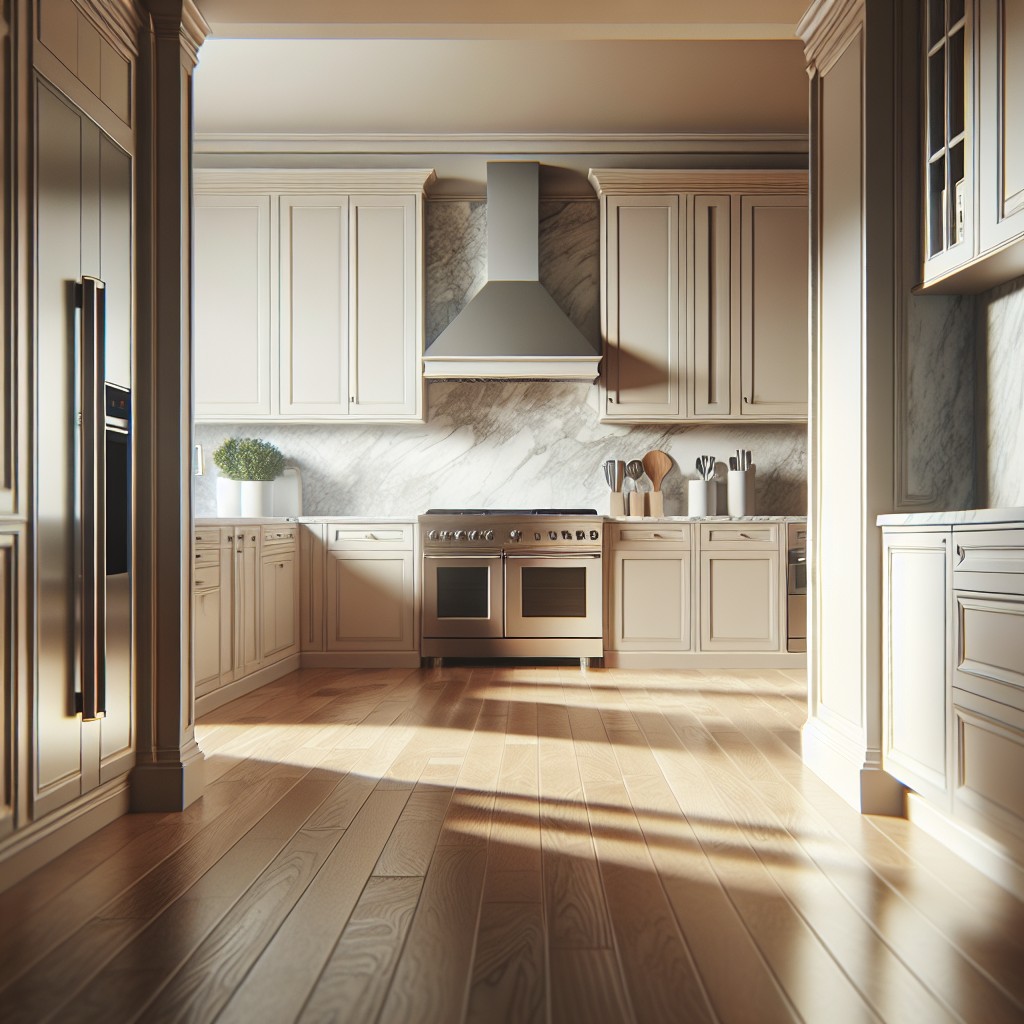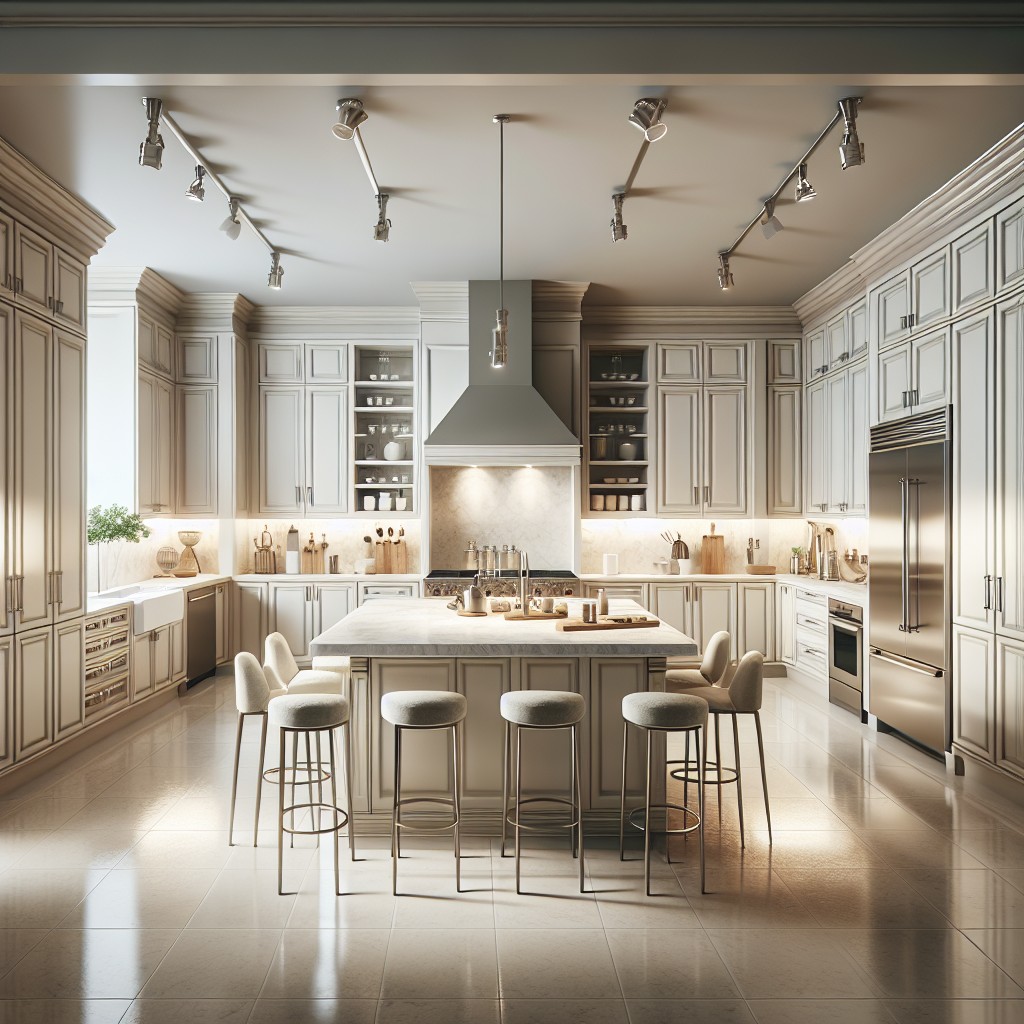Last updated on
Discover the sophistication of off-white kitchen cabinet colors because they effortlessly achieve a sense of elegance, tranquillity, and timelessness in your cooking space.
Key takeaways:
- Off-white cabinets create a timeless and elegant look.
- They complement various design elements and enhance the sense of space.
- Popular off-white cabinet colors include Alabaster, Antique White, Simply White, Swiss Coffee, and Linen White.
- Consider factors such as kitchen lighting, existing color palette, cabinet details, paint finish, and space size when choosing off-white cabinets.
- Proper painting techniques, protecting cabinets, and regular cleaning are essential for maintaining the beauty and longevity of off-white cabinets.
What's Inside
Overview of Off-White Cabinet Colors

Off-white kitchen cabinets offer a versatile and timeless appeal, bridging the gap between stark white and more pronounced hues. These subtle shades provide warmth to a space without overpowering it.
They serve as a neutral backdrop that can complement various design elements, from modern stainless steel appliances to rustic wooden countertops.
Off-white can also enhance the sense of space in a kitchen, reflecting light to make the room appear brighter and more open.
Moreover, this color category has the unique ability to adapt to changing trends, making off-white cabinets a smart choice for those looking for longevity in their kitchen design.
Advantages of Choosing Off-White Cabinets

Selecting off-white hues for your kitchen cabinetry can breathe life into the heart of your home. The subtly warm tones serve as a perfect backdrop, harmonizing with various color palettes and allowing for flexibility in changing decor styles over time.
They contribute to a bright and airy ambiance, enhancing natural light and making smaller kitchens appear more spacious. Unlike pure white, off-white mitigates the visibility of wear, smudges, and dirt, beneficial for a space that’s both functional and social.
Additionally, off-white’s timeless nature reduces the need for frequent updates, ensuring that your kitchen remains both classic and current without the need for perpetual renovations. This choice also elevates the resale value of your home, appealing to a broad range of potential buyers with its universal charm.
Popular Off-White Cabinet Colors
Creamy and warm, yet bright enough to refresh your kitchen space, Alabaster by Sherwin-Williams creates a welcoming ambiance. Considered a classic, it pairs beautifully with a variety of decor styles.
Antique White, another favorite, brings an element of coziness and pairs exquisitely with wood countertops and floors, offering a touch of rustic charm without overwhelming the senses.
Simply White by Benjamin Moore strikes the perfect balance for those seeking a crisp look without the starkness of pure white. It complements both modern and traditional settings, providing a fresh canvas for any kitchen design.
Swiss Coffee by Behr offers a muted sophistication, ideal for creating a tranquil and airy feel. Its adaptability in different lighting conditions makes it a popular choice for designers.
Linen White, also by Benjamin Moore, exudes an elegant and timeless vibe. This shade works wonders in spaces that aim for a chic yet inviting atmosphere.
Balanced against bold hardware or used as a backdrop for colorful decor, these shades not only elevate the aesthetic but also have the versatility to adapt as trends evolve.
Factors to Consider When Choosing Off-White Cabinets
Selecting the perfect off-white for your kitchen cabinets involves more than just picking a shade you like. Below are key considerations to guide you in making a choice that not only looks stunning but also complements your kitchen’s features:
- Kitchen Lighting: Consider how natural and artificial light play together in your space. Lighter off-whites can brighten a dim room, whereas creamier tones can add warmth to a kitchen with abundant sunlight.
- Existing Color Palette: Assess the colors of your countertops, backsplash, and flooring. An off-white that leans towards gray might pair well with cooler tones, while a beige-based off-white complements warmer hues.
- Cabinet Details: Think about the style and design of your cabinets. Highly detailed, traditional cabinets may benefit from a softer, muted off-white, which accentuates the craftsmanship, while sleek, modern cabinetry often pairs well with a cleaner and crisper off-white.
- Paint Finish: The finish can drastically affect the color’s appearance. A glossy finish might reflect too much light and look stark, whereas a matte or satin finish can soften the hue.
- Space Size and Ceiling Height: Light reflects differently in small or large kitchens and those with varying ceiling heights. A small kitchen might feel bigger with a lighter shade, while a spacious kitchen with high ceilings could handle a deeper off-white without feeling enclosed.
Remember to bring home samples to view them in your kitchen’s environment, as this will provide the most accurate representation of how the color will truly look in your home.
Tips for Comparing Off-White Paint Colors
When assessing off-white paint options, lighting is crucial. Observe the color at different times of the day as natural light shifts from warm to cool. Artificial lighting can also alter perception, so check the hue under LEDs, fluorescents, and incandescents.
Consider the LRV (Light Reflecting Value) of the paint. A higher LRV reflects more light, making the space appear larger and brighter. Conversely, a lower LRV can create a cozier, more intimate feel.
Place paint samples on different walls to see how shadows and architectural features impact the color. Always view colors alongside the elements they’ll accompany, from countertops to flooring, ensuring a harmonious palette.
Bring swatches of fabrics, furnishings, and other finishes when shopping for paint. This helps you visualize the color in the context of your kitchen’s design.
Finally, apply a test patch directly on the cabinet or wall. Live with it for a few days to see if it suits your style and the room’s ambiance throughout varied conditions.
Painting Techniques for Off-White Cabinets
Achieving a flawless finish on your off-white cabinets hinges on meticulous preparation and precise painting techniques. Start by removing hardware and cleaning surfaces thoroughly to ensure paint adherence. Sanding is crucial; it smoothens imperfections and provides a key for the primer. Use a high-quality primer to prevent tannins from bleeding through the paint.
When it comes to application, a foam roller creates a smooth, brush-mark-free surface, ideal for flat cabinet faces. For raised panels or intricate details, a high-quality angled brush is indispensable for getting into the nooks without leaving drips.
Opt for acrylic or oil-based enamel paint formulated for cabinetry for its durability and ease of cleaning. To avoid yellowing over time with oil-based options, select a non-yellowing formula if available. Several thin coats are preferable to one thick coat; they dry faster and minimize drips. Sand lightly between coats to eliminate any texture and ensure a glassy finish.
Final tip: Allow ample drying time between coats and before reassembling and using the cabinets to avoid fingerprint marks or damage to the paint job.
Protecting Off-White Cabinets From Wear and Tear
Safeguarding your off-white cabinets to maintain their pristine condition relies on proactive and preventative measures. Start by installing cabinet door bumpers to dampen the sound and reduce the stress on the paint when doors are closed. Utilize cabinet liners; these protect the interior from spills and stains, making cleanup a breeze.
Regularly tightening hardware, such as hinges and knobs, prevents unnecessary wobbling and damage—this simple act can extend the life of your cabinets significantly. For areas prone to grease and splatter, like those above the stove, apply a sealant to the painted surfaces, which creates a barrier against potential grime.
Be mindful of direct sunlight, which can lead to discoloration over time. Utilize window treatments like blinds or curtains to control exposure. Embrace a touch-up kit—it’s your best friend for addressing inevitable chips or scuffs promptly, keeping the cabinets looking as good as new.
Remember, the longevity of off-white cabinets hinges on these preventative tactics—small efforts result in lasting beauty.
Maintenance and Cleaning Tips for Off-White Cabinets
Keeping your off-white cabinets pristine is simpler than you might think. Regular dusting with a soft cloth helps prevent buildup of dirt and grease, especially if done weekly.
For a deeper clean, a mixture of warm water and mild dish soap does wonders, but remember to wring out the cloth well to avoid dripping. Avoid harsh chemicals or abrasive cleaners, as they can damage the cabinet’s finish.
For tricky spots like handles and corners, use an old toothbrush dipped in your soapy water solution – it’s perfect for reaching into those nooks and crannies. Always follow up with a dry cloth to remove any lingering moisture, which if left unchecked, could warp the wood or cause peeling of the paint.
Stickiness from cooking can be tackled with a solution of vinegar and water, a natural degreaser that’s safe for most surfaces. Apply it with a spray bottle and gently wipe away the grime. If you encounter stubborn stains, baking soda mixed into a paste may be applied, but use a light touch to avoid scratching the surface.
Lastly, maintaining the brightness involves immediate attention to spills and splatters. The quicker you wipe away substances like tomato sauce or wine, the less likely they will have time to set and mar the cabinet’s beauty. By incorporating these care habits, your off-white cabinets will retain their charm and luster, making them a timeless centerpiece in your kitchen.
Importance of Testing Colors in Different Lights
Natural sunlight can dramatically shift the perception of color throughout the day, from the warm hues of dawn to the cooler tones at midday. Under artificial lighting, shadows and highlights also come into play, often casting different colors in a new light—quite literally. Incandescent bulbs exude a warm glow, cozying up off-white shades, whereas LEDs might pull out cooler undertones, making cabinets appear crisper.
Conduct a test by painting large swatches on a movable board and observing how the color changes in your space from morning to night and under various artificial lights. This not only ensures the chosen hue resonates with you consistently but also highlights the importance of lighting in your overall kitchen aesthetic. This step may also reveal how the color interacts with other elements in your kitchen, such as countertops and flooring, guaranteeing harmony in your design.
Daily Cleaning for Lasting Brightness
To ensure your off-white cabinets retain their brightness, incorporate these daily cleaning habits:
- Wipe down surfaces: After each use, quickly pass a damp cloth over the cabinets to remove splatters and spills, preventing stains from setting in.
- Use gentle cleaners: Opt for mild soap and water or a specialized wood cabinet cleaner to avoid damaging the finish.
- Address spills immediately: Tackle any spills as soon as they occur, as prolonged exposure can lead to discoloration.
- Dust regularly: Use a soft microfiber cloth to dust the cabinet surfaces and hardware to prevent buildup.
- Polish sparingly: Occasionally apply a non-abrasive cabinet polish to enhance shine and provide a protective layer.
- Dry thoroughly: After cleaning, always dry with a separate soft cloth to prevent moisture damage.
By consistently applying these practices, you’ll maintain the cleanliness and brightness of your off-white cabinets, keeping them as inviting as the day they were painted.
FAQ
What color goes with off white cabinets?
Off-white cabinets can be beautifully complemented by either soft gray for a sense of elegance and sophistication, or pale blue for a more fresh and calming atmosphere.
Should kitchen cabinets be bright white or off white?
Opting for pure white kitchen cabinets is remarkable for modern or contemporary kitchens, providing a clean, fresh aesthetic that is ideal for smaller areas, although they may show dirt and stains more readily compared to off-white cabinets.
What is the best creamy white for kitchen cabinets?
The best creamy white for kitchen cabinets is Benjamin Moore Simply White (OC-117), owing to its soft and non-stark appearance in low natural lighting and its versatility in pairing with various colors.
What is the most popular Benjamin Moore off white for kitchen cabinets?
The most popular Benjamin Moore off white for kitchen cabinets is White Dove, characterized by its smooth, classic undertones and slightly warm complexion under specific lighting conditions.
How does natural lighting influence the appearance of off white kitchen cabinets?
Natural lighting can dramatically enhance the appearance of off-white kitchen cabinets, making them look brighter and more spacious.
Which countertop colors pair best with off white kitchen cabinets?
Off-white kitchen cabinets pair best with countertop colors such as light gray, beige, brown, and other earth tones.
What impact does the choice of hardware have on off white kitchen cabinets?
The choice of hardware significantly impacts the aesthetic and functional aspects of off-white kitchen cabinets, acting as a crucial element that enhances their appeal and usability.





